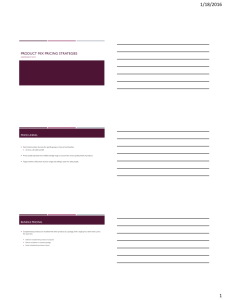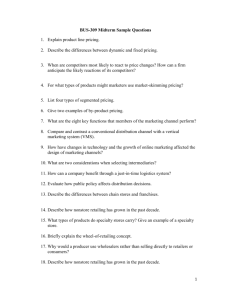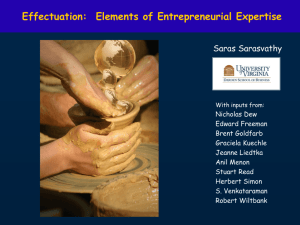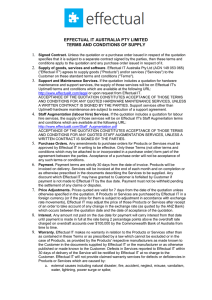Document
advertisement
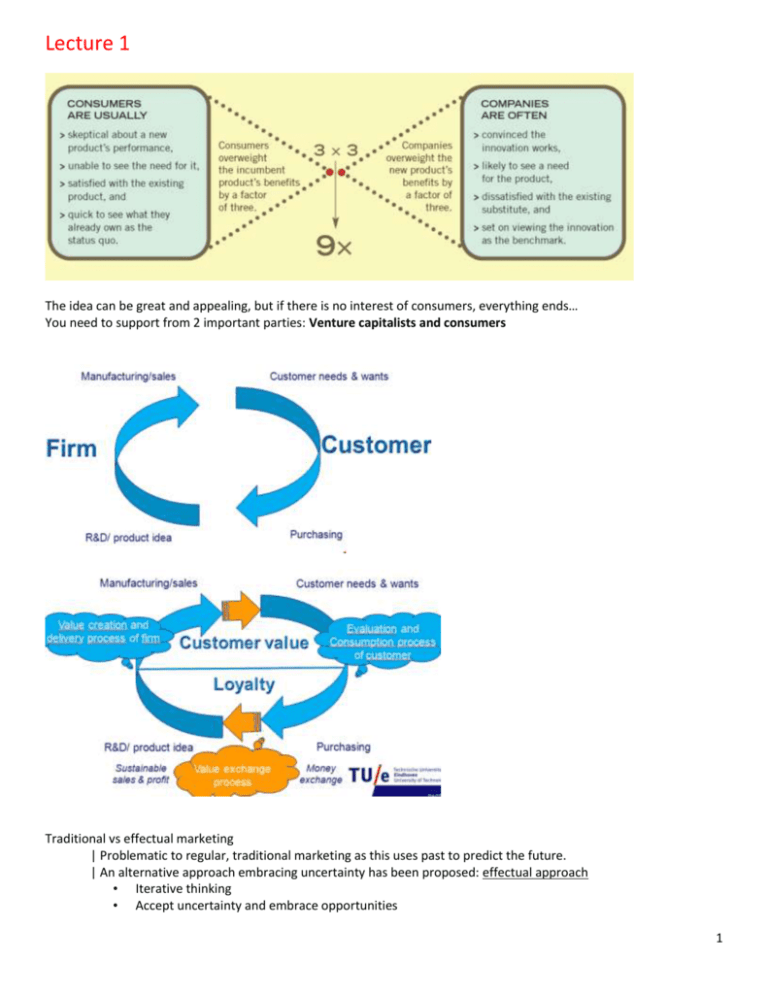
Lecture 1
The idea can be great and appealing, but if there is no interest of consumers, everything ends…
You need to support from 2 important parties: Venture capitalists and consumers
Traditional vs effectual marketing
| Problematic to regular, traditional marketing as this uses past to predict the future.
| An alternative approach embracing uncertainty has been proposed: effectual approach
• Iterative thinking
• Accept uncertainty and embrace opportunities
1
•
•
Marketing:
Sales:
Principle of affordable loss
Creative filling in of marketing mix for maximum effect but minimal cost
Analyzes the market and makes sure to develop and indentify manifest and latent
needs (creating need)
Makes the case why our product is the best choice and then aims to make a transaction
(filling the need)
Market Orientation: implementation of the marketing concept, which requires making market informed decisions based
on customer and competitor data that is systematically collected distributed and used through the organization
Marketing and market orientation have been shown to benefit firm performance
Products don’t sell Solutions do
2
Summary:
Engineers think that excellent products sell themselves
May be… but there are unfortunately very few excellent products developed
Moreover, products don’t sell, solutions (customer value) do
So, offer the product to customer segment that experiences most customer value from the new technology and
application effectual marketing
3
Lecture 2
Begin with you new technology/product and look for segment that sees trade-off (Gourville 2006) most positively
1. Select you application
2. Identify the market
3. Segment, Target, and Position your product
4
Effectual Segmentation and targeting
• Markets are heterogeneous; different groups have different needs and buying behavior segmentation
• This offers opportunities
• Customer value determines whether customer buys
• Needs to have high enough benefit over current product; current standard backs)
• Target the customers where customer value of your product is maximum (most positive trade-off
situation)
• Position to emphasize this value
Market = a place where customers and providers meet
Relevant:
Customer groups
Needs
Technology
The new technology and benefits etc can be added on axes (dynamic orientation).
• The technique helps to understand the market and actively links to customer needs
− It helps you to conceptualize your market and explore boundary conditions
− Products are in the matrix; they are the linking mechanism
However, no single solution exists
5
Different levels of competition:
• Product competition
• product class
• product form and brand competition
• Need competition (e.g., substitutes)
A Special Case: Network products
• “products whose value increases as more users adopt the product, or by presence of complementary
products” (Lee and O’Conner 2003).
• Three sources
• Direct effects (e.g., fax, video conferencing)
• Indirect effects (e.g., e-readers e-books)
• Standardization issues (which will become the dominant standard?)
• Consequence: Selling more is not just beautiful but necessary! Why?
Network products: Rapidly increase your installed base
6
Summary:
• STP marketing is the basis. Select your first segment carefully, but develop senario of attack
• A niche or beachhead approach is best suited for firm’s with limited resources. It helps to avoid head-on
competition
• Be aware of possible network effects (direct and indirect)
• Develop a perspective on your market (Abell) and bowling alley; begin with segment where benefits high and
drawbacks of early stage of development low, i.e. do not matter
Emphasis on core marketing concepts
1. Developing vision on bowling alley
− Identifying applications and segments
− Identifying the best –pin-- application
2. Conceptualizing the market using Abell’s 3D model
− Technology-customer group-customer needs linkages
3. Practicing segmentation/positioning using cardboard bycicle idea
− Find segment for whom trade-off is most positive
4. Strategic issues
− Niche or beachhead approach (military strategy)
− Network effects
7
8
Lecture 3
Positioning statement:
Technological Advantage
Discrimator
Customer insight
Reasons to believe
9
Decision Making Unit (DMU):
• Often multiple people are involved in the decision to adopt a product (stakeholders)
• Roles include
− gatekeeper
− influence
− decider
− buyer
− user
• Determine who is sensitive to which arguments? And, adjust message for each party (Micro marketing)
10
Innovation theory: normal distribution. Focus on enthusiasts
Danger of Chasms (afgronden)
Article on google: Crossing the Chasm
by Geoffry Moore
•
•
•
innovators
• Venturesome
• Like new technology and less sensitive to some deficiencies
• More strategic considerations than pure economical
early adopters
• More rational and thus more skeptical; more pragmatic
• However, you may use opinion leaders to convince
• Emphasize the quality of your solution and economic and strategic gains
Danger of chasms as you move along the axis. Be prepared to chaneg marketing arguments and efforts
HBR study shows important conclusions:
• Many entrepreneurs wait too long before involving their customers
• As a result they make too many investments and loose time
• They lack feedback to iron out obvious kinks
• Solution
• Involve customers a.s.a.p
• Listen to their feedback; optimizing your product/idea
• Validate your idea and repurpose your product if necessary
• Search for lead customers
− Technology enthusiasts that are ahead of the market
− Often willing to invest time and money
11
Danger of Chasms:
Need to plan ahead
Summary:
• We discussed adoption
and diffusion
- Adoption characteristics
• Impact of lack of reputation/liability of newness
• Customer also factors in technology dimension in evaluation
- Customer behavior,
- DMU/stakeholders
• Roots of adoption; customer behavior, DMU/stakeholders
• The difference between innovator customers and early adopters chasms
• By focusing on adoption factors you can influence customers progress in adoption process
• Importance of involving lead customer
- To help co-develop
- To help co-finance
- To ensure link with customer needs
- Important first reference to attract more customers
12
At the end you should have the target segment and positioning validated
Types of business models [Weill et al. 2005]
• Creators: raw materials transferred into products/services
• Distributors: buys and resells (some value is added)
• Landlords: sells the right to use but ownership is not transferred
• Brokers: middle man bringing buyer and seller together
Blank (2006)
• Although NPD includes customers and marketing activities, generally technical issues crowd out commercial
elements
• Hence, it is better to distinguish customer development and award it separate status
Often Entrepreneurs wait too long before involving customers
The complementary processes of new product and customer development:
From NPD to Customer development:
13
Summary:
•
•
•
•
Customer development is best separated from NPD process
It requires management that can bridge with
• NPD process
• Links to Business model /business case development
• Best to also involve a team and make marketing/sales person responsable
Important to simultaneously work on marketing and sales activities and capabilities building
Customer involvement is key
14
Lecture 5
Marketing: Translate value proposition in marketing mix
15
Best practices in sales encounters:
• Listen to understand customer frustrations/ problems and thus latent needs
• Get feedback on you product
• Educate customer if necessary; offer information about your product/technology
• Show empathy
• Deliver short and targeted message
Promotion: The communication challenge
Goal is to build Awareness: “ build mind position”
Important for:
- Reputationless start-up
- As awareness is first step in loyality building
Aim:
Top Of Mind position
Correct and positive associations
Generate trial
Basic communication model: AIDA
Attention Interest Desire Action
Product as bundle of attributes
16
Pricing is a complex task: many facets to consider
• Quality signal (e.g., services; image product)
• Strategic pricing (skimming vs. penetration)
• Tactical pricing (bijv 9.999 euro)
• Immediate impact on profit of the firm
Anticipated volume allows for more aggressive pricing
Price sensitivity
• Inelastic vs. Elastic demand;
• Availability of alternatives may play a role
Patent protection implies ‘no competition’ and thus chance for price skimming
Price objective:
• Survival***
• Maximize market share (e.g., network product; crowed out competition; prevent entry)
• Maximize skimming (e.g., leverage your patent)
• Maximize profits
• Product-quality leadership (positioning goal)
• Other (e.g., not for profit)
17
Estimating costs:
Fixed costs: costs that donot vary with production or sales revenue, rent, heat, interest, salaries etc.(i.e.
overhead)
Variable costs: vary directly with the level of production, e.g. raw materials and purchased components of a
product as well as its packaging materials
Don’t foget include marketing and sales costs!
Pricing methods:
Markup pricing: Unit costs = var. cost + (fixed cost / unit sales) | markup price = unit price /(1-desired return on
sales)
Target return pricing:
Target Rate of Return on Investment:
- Target return price = unit cost + {(desired return x invested capital)/unit sales}
Break even volume:
- Fixed cost / (price-var cost) = xxx units
Unfortunately target return pricing tends to ignore demand elasticity and competitive considerations
Perceived value pricing (compare competitor oriented pricing)
This price focuses on the value exchanged and perceived by the customer. For instance, Caterpillar uses
it for construction equipment
Summary:
• We discussed making simple marketing/sales plan
• Content of promotion, product and price elements
• Core decisions
- Promotion creating awareness. If people are unaware they will not search and may fail to buy
when they do encouter
- Product make simple product (line) for target segment to limit cost. You may develop more after
take off
- Price do not immediately gravitate towards cost-plus but look at value of your product. Make
sure to factor in marketing cost
18
Lecture 6
Place (distribution)
• Distribution concerns the moving products from provider customer
• Often it involves a network to efficiently transport and reduce large to small product quantities
• Direct vs. indirect (compare short/long) channels
• Channel shoud add value to your product
• Availability
• Right time+quantity
• Advice, installation
Two key issues for the entrepreneur
Gaining access to the channel / customer
Obtaining a good presence in the channel and market (channel should also add value for end customer)
19
Organizational development: don’t forget building commercial capabilities!
Summary:
•
•
•
•
•
We complemented the discussion of marketing mix with discussion on place
All elements are important
• Promotion: to create awareness and positive associations. It should help and support sales force and its
effort
• Place: should ensure access to customers. Often entrepeneurs rely on the Internet to circumvent
channel blockage
− Prevent getting locked into relationships that don’t work
− Use low cost approach but aim for maximum impact using creativity.
• Price: directly affects your cashflow and profits. Prevent strong discounting in beginning to not create
negative spiral
• Product: Experimenting should help identify right features. Then design final product and think about
product line
In building commercial competencies shift from effectual to regular marketing after survival stage;
Grow your sales force only after customer validation has been completed and initial sales roadmap developed.
• Speed up customer development
• Move from hunting to hunting/farming customers
Keep track of customer satisfaction and loyalty by actively collecting feedback
• Build a customer and market information system to support future decisions
• Develop marketing indicators /measures and build marketing dashboard
20
What is a VAR (Value Added Reseller)?
• A value-added reseller (VAR) is a company that adds features to an existing product, then resells it (usually to
end-users) as an integrated product or complete "turn-key" solution. This practice occurs commonly in the
electronics industry, where, for example, a VAR might bundle a software application with supplied hardware.
• The added value can come from professional services such as integrating, customizing, consulting, training and
implementation. The value can also be added by developing a specific application for the product designed for
the customer's needs which is then resold as a new package.
• Resellers may have pre-negotiated pricing that enables them to discount more than a customer would receive
by purchasing directly.
21
22



